Blagdon Lake Birds
1st National Nathusius's Pipistrelle Conference
24th August 2013 at Ubley Village Hall
Tony Moulin, Chairman of Yatton & Congresbury Wildlife Action Group (YACWAG), opened the conference by welcoming the delegates and speakers and took the opportunity to present conference organiser Daniel 'Batdan' Hargreaves with a token of thanks from YACWAG for all the work he has done in promoting the conservation of bats locally. There is undoubtedly a sense of loss now that Daniel, Heidi and Poppy have moved to Dover, but thanks to the solid foundations laid by Daniel within the bat group, it is hoped that several of us will get our bat workers licences and be able to carry on where he's left off. I'd like to add my personal thanks for inspiring me to get involved too.
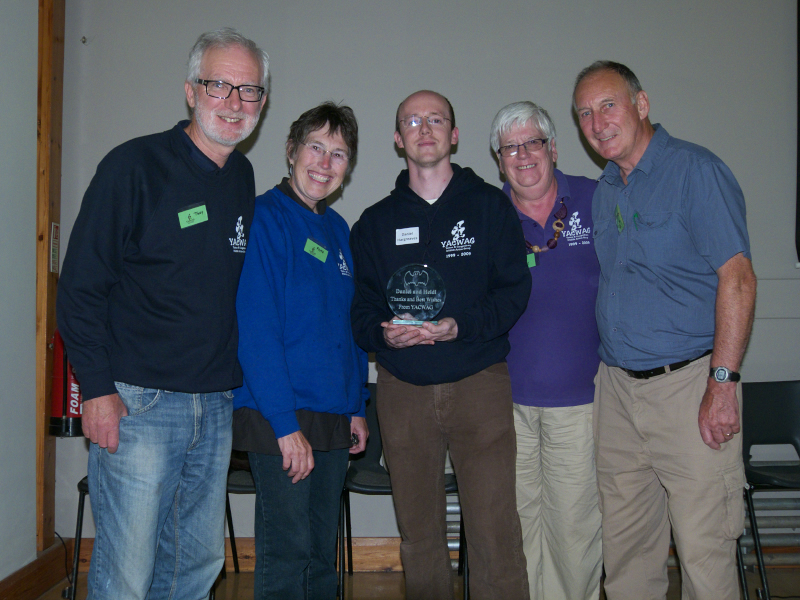 Presentation to Daniel Hargreaves by YACWAG
Presentation to Daniel Hargreaves by YACWAG
Tony (on the left above) then introduced the first speaker Dr Jon Russ who opened the conference:
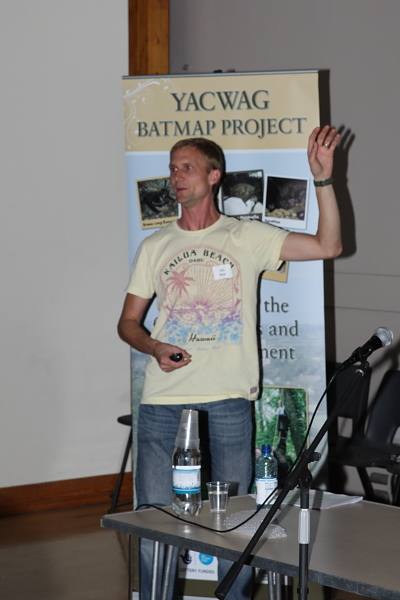
Nathusius's Pipistrelle in the UK – what we do and don't know.
We do know:
Recent records support the previous findings that there is a resident population of Nathusius’s pipistrelle in both Great Britain and Ireland.
There is evidence of spring and autumn migrations to Great Britain.
This migratory population mixes with resident populations. This may also be the case in Northern Ireland.
However, at present there is no evidence of either hibernation in Northern Ireland or migration to Ireland from Britain.
There is evidence of past, present and future range expansion within Great Britain and Ireland which could be linked to climate change.
Large lakes appear to be important sites for Nathusius’s pipistrelles.
We don't know:
Migration routes – offshore and onshore routes.
Where do our migratory bats come from?
Are sedentary and migratory populations separate? Do some migrate one year and stay the next? What causes bats to stay/leave?
Ireland – why such a relatively stable sedentary population? Do bats migrate to Ireland?
Ireland – is there a remnant population?
Records seem scarce in Rep of Ireland. Why?
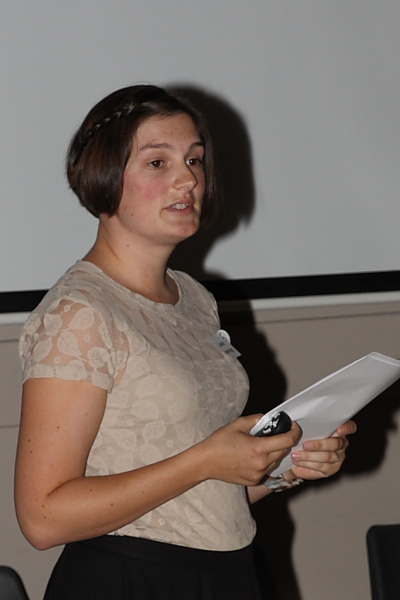
Laura Jennings from BSG Ecology then told us about her Nathusius's Pipistrelle - Kent Migration Study.
A two part study that started by using fixed static AnaBat detectors to remotely monitor bat activity at Dungeness Bird Observatory in 2012 and 2013, the National Trust at The White Cliffs of Dover and Sandwich Bay Bird Observatory in 2013. Nathusius's were recorded at all sites with the highest number of passes at Sandwich Bay. There are two schools of thought with regard to bat migration into and out of Britain. The first is that bats from south-western Europe come to the UK to breed in spring and depart to hibernate in autumn. The second is that they come to the UK from north-eastern Europe to hibernate in autumn and leave in spring to breed in mainland Europe. It is also possible that a combination of both scenarios is occurring.
The second element of the project involves working with the Kent Bat Group to capture bats in flight and at roost sites along the coast. We will also coordinate with bat workers and other bat groups, including but not limited to those in North Bucks, Herts and Mon. This will enable fur samples to be taken for stable isotope analysis to consider the likely origins of bats trapped. Firstly we hope to build a stronger evidence base that indicates that bats migrate into and out of the UK. Bat activity will also be evaluated to see if this is a correlation with the time of the day and weather conditions. Secondly, through the stable isotope analysis we would potentially identify where immigrants are coming from, establishing incontrovertible evidence of migration.
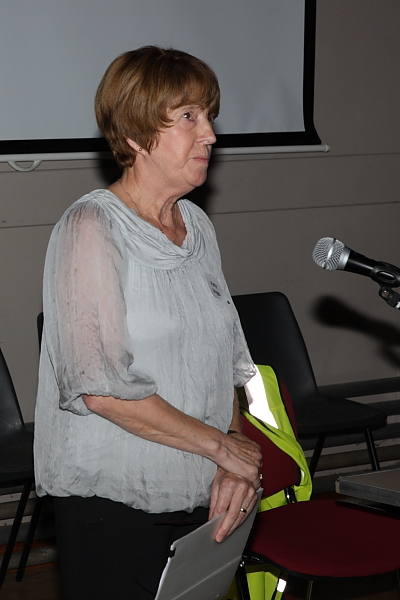
Then Patty Briggs followed by telling us about the Bedfont Nathusius Project based around the Bedfont Lakes Country Park near Heathrow Airport, the second largest open space to be created in London in the 20th century. It was an area of gravel extraction since the 1860s that was subsequently landfilled until 1973, before landscaping and opening to the public in 1995. In 2007 it was designated as a Site of Importance for Nature Conservation (of Metropolitan Importance).
Patty showed us lots of pictures of the site but went on to say that, unfortunately, Rose-ringed Parakeets are causing a problem by destroying Schwegler bat boxes, and Goat Moths are attacking the trees. The excellent mix of habitats, including open water, has attracted Nathusius's Pipistrelles to use bat boxes put up by the group, so they have been monitored since 2002 and the design that seems to attract Nathusius's at Bedfont more than any other appears to be the 2F-DFP (though numbers are small).
Patty also said a few words about how the group have been modifying the boxes and are hopeful that the design may be picked up by the makers.
So far, a total of 23 Nathusius's have been ringed, 9 males and 14 females, with 3 recaptures including one individual that has been caught 4 times. The largest group in a single box was 7 individuals and no mixed species roosts have been found.
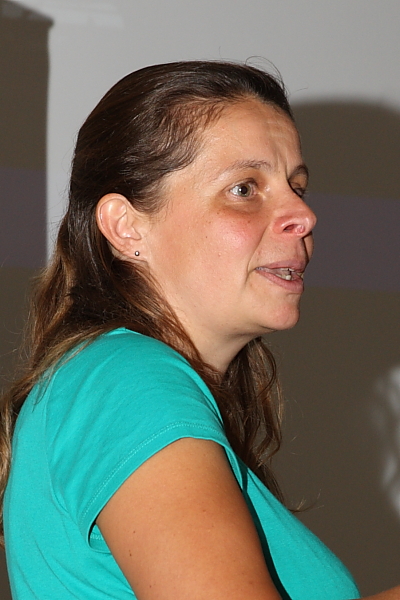
So far no roosting bats have been found and its not proved as easy as was thought. So, perhaps one should try to catch and follow them back to the roost?
Two MSc students at Newcastle University were sponsored with one to drive transects to determine habitat factors that influenced the presence of bats and the other to look at the influence of weather conditions on bat activity.
A SM2 passive detector was fitted on a cross-channel ferry but didn't record any bat passes.
This year it was decided that as no roosts had been found, the group should create one by putting bat boxes up in Gosforth Park Nature Reserve.
So far, 50 volunteers have been involved with the project, totalling 235 volunteer evenings in 2012, regular social events are held, new skills have been learned, information has been shared and Nathusius's Pipistrelles have been recorded.

Ross Baker from Surrey gave the last talk before lunch on Nathusius's Pipistrelle at Claremont Landscaped Garden, Esher. Nathusius's were recorded for the first time in 2002 on the River Mole at Esher, and by the time the project started there had been 20 records in Surrey with 5 from Claremont since 2007. The aims of the project are to provide “in hand” proof of presence, to measure encounter rate throughout the year, to characterise how bats use the site, to look for evidence of breeding, to identify roosts within the site, or flightlines bats are using to enter the site, and to identify roosts off the site. Methods used in an effort to achieve the aims include automated SM2 BAT+ surveys, manual detector surveys on and off site, and harp trapping with an acoustic lure.
To date, the group has detected activity at the control by the lake throughout year, found peaks during late June and mid-September in 2012 and during early May and early June in 2013, identified a possible flightline, recorded distinctive social calls throughout September 2012 and verified their presence in-hand.
The SM2 was passively recording during the winter for 148 nights from 1st Nov to 13th April and detected bats on 81 nights (55%), with Nathusius's recorded on 29 nights (20%) at a lowest temperature of 1.4 Celsius.
Future plans include continuing the SM2 surveys through 2013, more trapping during the breeding season, trapping at other sites in north Surrey and possible radio-tracking and stable-isotope research.
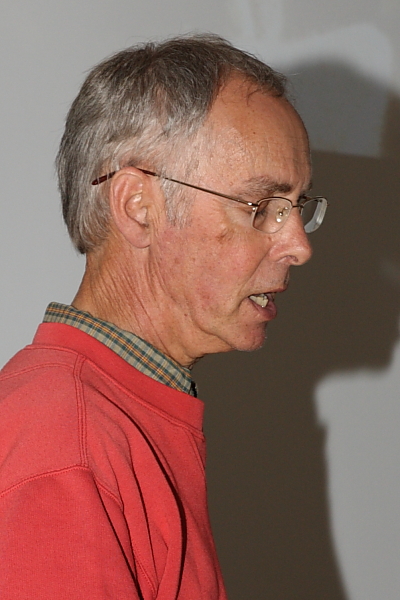
After the break, John Puckett detailed the Current Status of Nathusius's Pipistrelle in Kent.
John started his talk by telling us about Nathusius's in Lydd nr Dungeness. A friends house in an estate has attracted the bats to roost, presumably because there are no suitable sites out on the gravel, though there is open water over which they could feed. He also showed us a church where the bats have access and have apparently been roosting above heating boilers.
There are many coastal records scattered around the Kent coast from Chatham to Lydd and it has been proved that several old sites hold hibernation roosts.
Bat detector records are widespread throughout the county from Edenbridge in the west to nr Ramsgate in the east with a particular cluster east of Canterbury along the Great Stour Valley in the vicinity of Stodmarsh where there are many lakes.
John showed us a graph of 16 in-the-hand bats by month, which once again show the typical peaks in May and September.
He plotted bat detector records by month, which also show a Septemeber peak, with another in July. One cannot draw too many valid conclusions from the data though because the number of records is small and we have no idea of the relative effort made in recording them by time. However, we can see that Nathusius's Pipistrelles are widespread in the county.

Philip Briggs of the Bat Conservation Trust showed us how he is Mapping the Autumn Distribution of Nathusius's Pipistrelle across the UK using records from the Nathusius’s Survey which has been running as part of the National Bat Monitoring Programme since 2009. The main aim of the survey is to fill in gaps in our knowledge of this species’ autumn distribution. It is the first UK-wide systematic survey and uses a standard survey method to aid interpretation, should fill in gaps in the known distribution and elsewhere, will allow us to carry out repeat site surveys to look at population changes and help meet the reporting requirements of the Habitats Directive because the population trend is currently given as "unknown".
203 sites have been surveyed over the period 2009-2012, with Nathusius's verified at 60 (30% of sites surveyed) by sound analysis. 16 more sites had “unsure Nathusius’ pipistrelle” identified through sound analysis, and a further 72 sites (35% of sites) have had unverified Nathusius’ pipistrelle records from heterodyne detectors. Philip pointed out there are a number of limitations in the data viz. that there are similar gaps to Jon’s distribution map, some areas have a limited number of accessible large water bodies, tells us about autumn distribution when bats are migrating through, but not about resident UK population, and also tells us that this species is present and at which sampling locations but not much about the populations at each site, e.g. are the bats males or females, adults or juveniles etc.
In the future, we should continue gap-filling, targeting priority areas with lowest coverage, repeat site monitoring to look at population changes, carry out power analysis to assess what sample size is needed to detect population change, set up online recording, carry out surveys in spring and summer and use data to identify sites for trapping surveys and year-round passive monitoring.
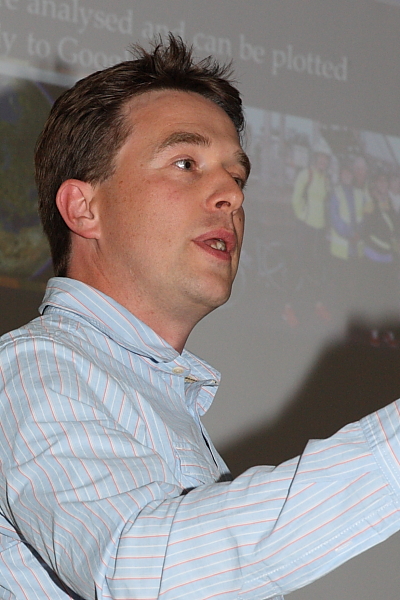
Richard Crompton informed us that recent investigations have proven Nathusius's are present in Cardiff, in his talk The Cardiff Bat Group Nathusius's Pipistrelle Project. Nathusius's Pipistrelle has been regularly recorded around Cardiff since first identified at Cardiff Bay by Richard Dodd in 2008, but only two roosts have been identified in Wales to date, at Neath Port Talbot (2004) and Laugharne (2011). In 2010 a single adult male was caught during a training course at St Fagan's Museum, and since 2011 University of Glamorgan student projects have recorded Nathusius's repeatedly there each summer since 2011. The Bats and Bikes project recorded them along the River Taff.
As a result, a tracking project was designed to find roosts with trapping sites focussed on safe accessible areas close to clusters of detector records. A combination of harp traps, mist nets and acoustic lures will be run at four different sites during April-early May, and August-October. Five tags were purchased with a grant. Early success when an adult male Nathusius's Pipistrelle was caught in a harp trap at 22.10 hrs on 22nd August 2013 at Stryd Lydan Barn, St Fagans Museum. It was fitted with a 0.37g Biotrack radio tag with increased power, but reduced 7-day battery life – to make roost finding a little easier. Initial tracking results have shown that immediately after capture the bat flew to a copse of mature beech trees and remained there for around 40 minutes. Then, the bat was observed flying and feeding of over the area where he was caught and is day roosting in the Gardener’s House; a Museum building just 200m from where he was caught.
To be continued...
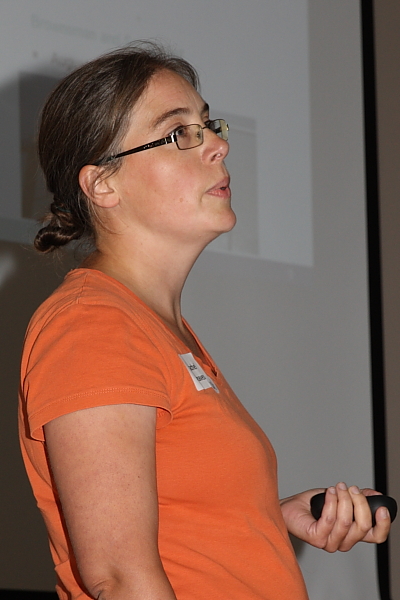
Rachael Greaves has been investigating Island Bats; Nathusius's off the Northumberland Coast on Lindisfarne, Innner Farne and Coquet Island.
SM2 passive detectors, powered by solar panels, were used and have detected bats on all the islands with all three species of pipistrelles recorded on each.
Lindisfarne has a lot of bat activity suggesting resident bats, while Coquet and Inner Farne are too small to support bat populations so they must be flying over the sea. But are they migrating or foraging?
Nathusius's records were compared with wind speed, wind direction, moon illumination and barometric pressure.
It was concluded that wind direction and barometric pressure do not appear to influence Nathusius’s movements though wind speed and moon illumination may have some influence.
Nathusius’s records are temporally clustered (mainly from August through October) and are occurring on 2 or 3 islands within a few days of each other. So, Nathusius’s (and other species) are crossing the sea, but we don't know where they are coming from and what is driving their movements.
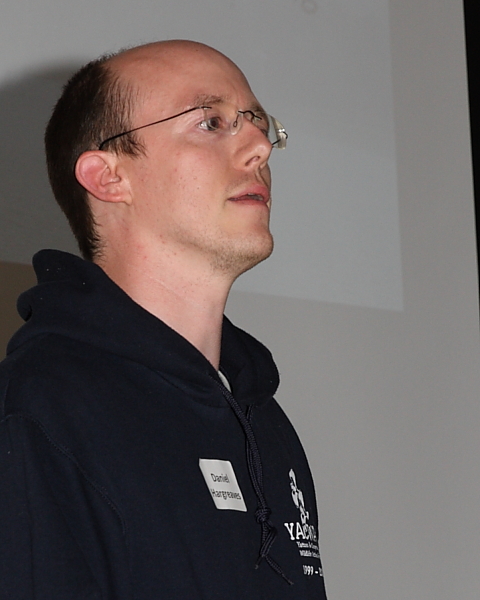
Finally, we came to 'Local Hero' Daniel Hargreaves, who expounded on the YACWAG/BCT Nathusius Project 'Nathusius's Pipistrelles at Blagdon Lake'. In 2010 acoustic records showed them to be present all year round, there was lots of activity so we presumed there to be a good population with possible breeding sites nearby. So, a plan was hatched to “catch a female, radio track, find and document the maternity roost and monitor the population.”
During 2011-12 we caught 24 individuals, found 4 roosts, found one “advertisement” site, mapped foraging habitat, noted emergence times (30-45 minutes after sunset) and noted foraging time (461 mins in Apr. to 87 mins in Aug.). On the face of it, this was a success, BUT we only caught males! We concluded there were no females or juveniles, that perhaps the lures only attract males, females don't breed locally, perhaps there is sexual segregation spatially and that migration was probably involved. 2013 saw the same methods being employed and and we caught 3 adult females, none of which showed any sign of breeding. One was radio-tracked for 11 nights during which it moved roost and foraged from the west end of Blagdon Lake to the west side of Chew Valley Lake. What do we conclude now? Males roost alone, we have no idea about the females, they may breed locally and just possibly they didn't migrate due to a bad winter.
Future plans include systematic trapping surveys, remote sound recording, behavioural surveillance, radio tracking of more females or juveniles and trapping sessions at adjacent large water bodies.
There followed a short general discussion about how we might take forward the interest in Nathusius's Pipistrelles in a co-ordinated way at a national level. No firm decisions were made by the group, but it is to be hoped that a committee will be set up to put together proposals for consideration by all those involved.
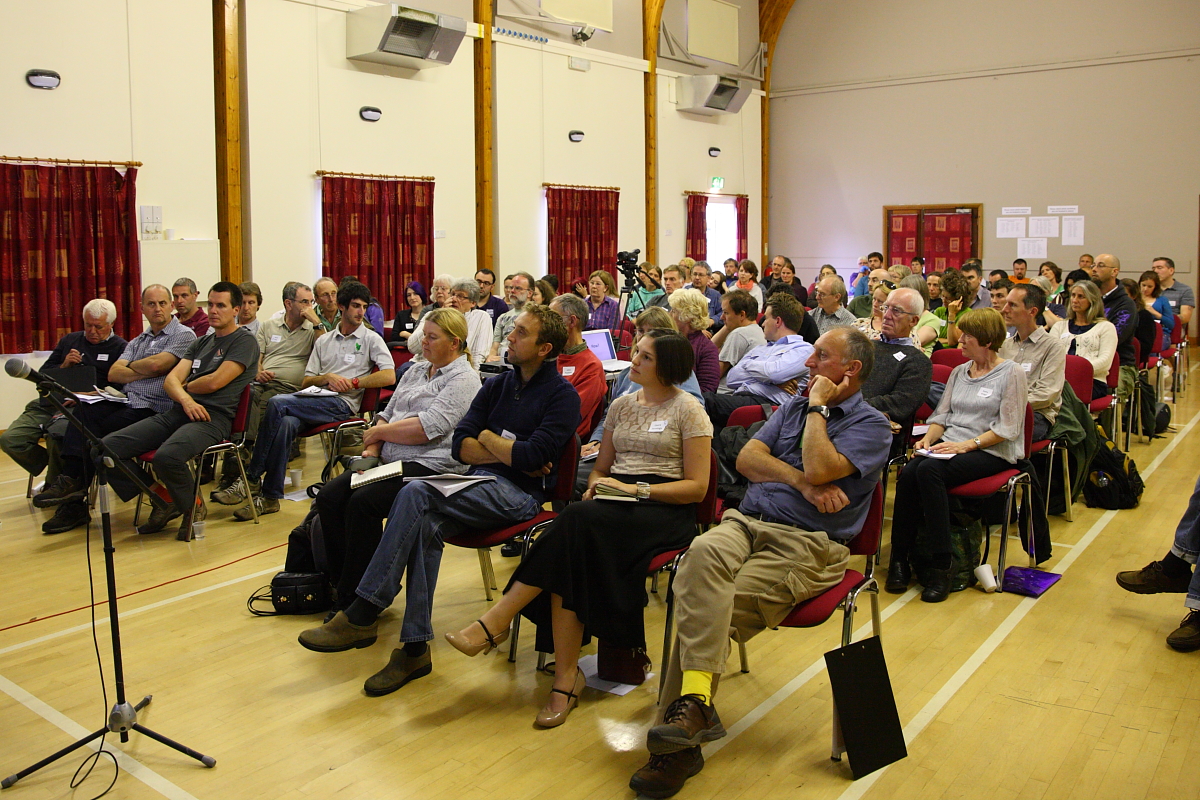
Chairman for the day, Tony Moulin of YACWAG, did a great job keeping the conference on track and at 1530 hrs we split up into groups to attend four workshops:
- Stable Isotope Analysis – what does it all mean? with Dr. Fiona Mathews
- Nathusius's Pipistrelle identification and acoustic detection with Dr. Jon Russ
- Catching methods and use of acoustic lures with Daniel Whitby
- Marking and radio tracking methods with Daniel Hargreaves
When the conference ended, delegates went to find something to eat and prepare themselves for the evening field meeting at Blagdon Lake where Daniel was hoping to capture some Nathusius's to further our understanding of how they are using the site. There were 6 groups spread around the lake as shown on the map below, each with a licensed bat worker, harp trap and support team.
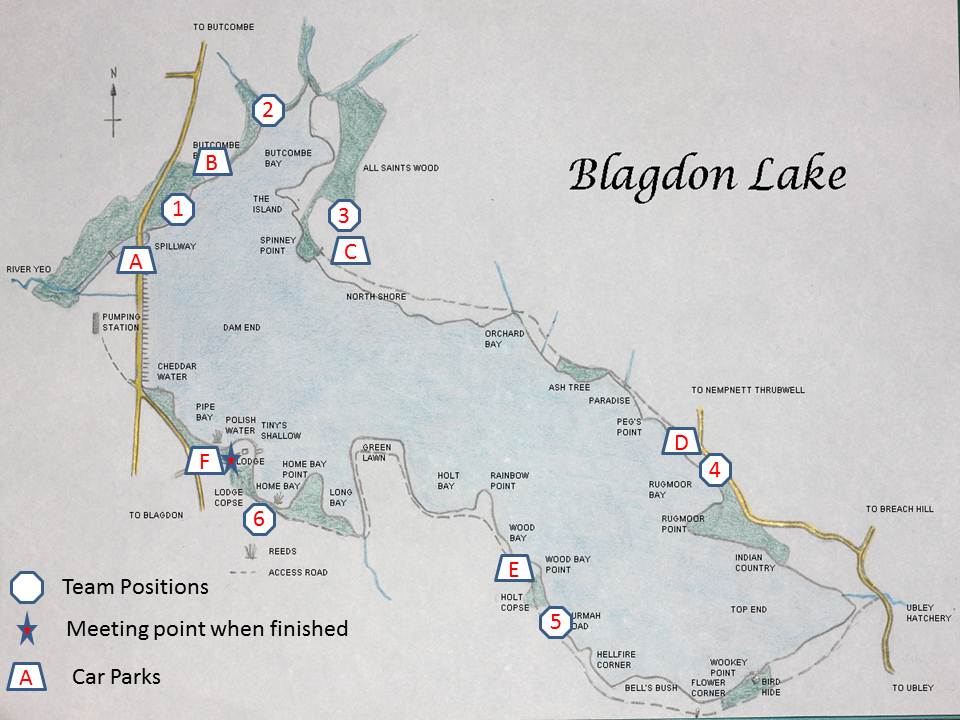
- Site 1: Butcombe Bank ST5060
- Site 2: Butcombe Bank ST5060
- Site 3: All Saint's Wood ST5060
- Site 4: Rugmoor ST5259
- Site 5: Holt Copse ST5159
- Site 6: Lodge Copse ST5059
An amazing 87 bats of 8 species were caught on what was, rather appropriately, International Bat Night 2013.
| Vernacular Name | Scientific Name | Site 1 | Site 2 | Site 3 | Site 4 | Site 5 | Site 6 | Total |
| Lesser Horseshoe Bat | Rhinolophus hipposideros | 1 | 1 | |||||
| Daubenton's Bat | Myotis daubentonii | 8 | 1 | 1 | 10 | |||
| Whiskered Bat | Myotis mystacinus | 1 | 1 | |||||
| Natterer's Bat | Myotis nattereri | 1 | 1 | 2 | 4 | |||
| Nathusius's Pipistrelle | Pipistrellus nathusii | 3 | 2 | 5 | ||||
| Common Pipistrelle | Pipistrellus pipistrellus | 2 | 1 | 1 | 1 | 5 | ||
| Soprano Pipistrelle | Pipistrellus pygmaeus | 13 | 8 | 3 | 18 | 4 | 13 | 59 |
| Brown Long-eared Bat | Plecotus auritus | 1 | 1 | 2 | ||||
| 26 | 10 | 4 | 22 | 8 | 17 | 87 |
The 5♂ Nathusius's Pipistrelles were all new animals because those caught previously at the lake have all been ringed by Daniel - a total of 30 or so. During the evening there were 2♂ Nathusius's Pipistrelles advertising from the Bat House at Pipe Bay. One under the usual tile, on and off, all night until dawn, and another was seen earlier in the evening nearer the apex of the roof.
Special thanks to the organisers Daniel Hargreaves (YACWAG), Jon Russ (Ridgeway Ecology) and Lisa Worledge (Bat Conservation Trust) for a fantastic day (and night). Thanks are also due to the YACWAG members who made the day run so smoothly by car parking, meeting and greeting, tea/coffee making, running the projector and chairing the conference. The speakers who gave of their time and knowledge to inform us and the delegates who came from all over the country combined to make this first conference an outstanding success. Last, and by no means least, thanks to Topline Catering for the lavish spread and Bristol Water for their sponsorship and permission to 'Bat at Blagdon'.
Nigel Milbourne